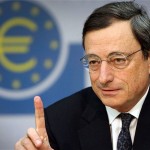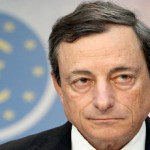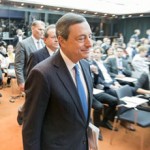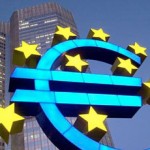Currency Carry Trades Rise in ECB’s Negative-Rate World
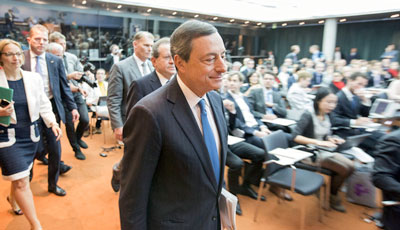
Mario Draghi is becoming one of currency traders’ only friends.
With the $5.3 trillion-a-day foreign-exchange market poised to deliver its worst first-half returns on record, the carry trade is about the only way traders are making money by exploiting differences in global borrowing costs as volatility tumbles. That strategy became more profitable after the European Central Bank president cut interest rates on June 5.
“The ECB has signaled risk is on again,” Eric Busay, a Sacramento-based money manager at the California Public Employees’ Retirement System, the largest U.S. public pension fund with $294 billion in assets, said in a June 6 phone interview. “People are concerned when to exit the trade and they understand the rush to exit could be crowded. But at the same time, you have to be in it to win it.”
A Deutsche Bank AG index that measures returns from a trade that buys the world’s five highest-yielding currencies, including South Africa’s rand and the New Zealand dollar, has jumped 1.3 percent since Draghi’s announcement, bringing its advance to 4.4 percent this year.
Deutsche Bank’s Currency Valuation Excess Return index that makes investments based on relative purchasing powers was little changed since Draghi cut rates, while the Currency Momentum Excess Return gauge, which buys assets that are rising the fastest, declined 0.6 percent. The indexes gained 0.7 percent and lost 4.6 percent this year.
Further Measures
Draghi’s announcement of rate cuts and hints of further measures to come gave markets the confidence that global central banks aren’t finished with the policies that are suppressing volatility and allowing carry trades to thrive.
JPMorgan Chase & Co.’s Global FX Volatility Index plunged to a record after the ECB’s meeting in Frankfurt, making it less likely carry trades will be upended by exchange-rate moves and banishing concern that returns were becoming overstretched.
The biggest beneficiaries of trades where investors borrow in economies with low rates and use the proceeds to buy financial assets where they are higher are emerging markets. Since the ECB meeting, the top five among 24 developing-market currencies monitored by Bloomberg have been Brazil’s real, Russia’s ruble, Turkey’s lira, the rand and Malaysia’s ringgit, all gaining 1 percent or more against the dollar and euro.
‘King’ Carry
“We warned last week that long emerging-market foreign-exchange positions in Asia and Latin America were getting stretched, but we see no signs of these flows slowing yet,” Athanasios Vamvakidis, head of Group of 10 currency strategy at Bank of America Corp. in London, wrote yesterday in a client note, referring to bets an asset will appreciate. “Post-ECB, carry is still king.”
Deutsche Bank’s Balanced Currency Harvest carry-trade index closed at 260.46 yesterday, about 0.8 percent from the highest level since June 2013, bouncing back from its biggest weekly loss since January.
While the 33 percent slump in JPMorgan’s volatility gauge this year is helping carry trades, it’s hurting other strategies by smoothing out many of the trends dealers rely on for profit.
The measure plunged to an all-time low of 5.76 percent on June 6, the day after the ECB meeting, from 6.56 percent the day before. It peaked at 27 percent in October 2008, after the collapse of Lehman Brothers Holdings Inc. during the depths of the global financial crisis.
‘Very Low’
“With the ECB meeting out of the way, we expect volatility to stay very low,” Steve Barrow, the head of G-10 research at Standard Bank Plc in London, said yesterday in a phone interview. “It makes me more bullish on the carry trade because volatility is the enemy of carry, and if volatility is low that plays into the hands of the trade.”
At its monthly policy meeting last week, the ECB cut its deposit rate to minus 0.1 percent, becoming the first major central bank to take one of its main rates negative, and reduced its main refinancing rate to 0.15 percent, from 0.25 percent. In Brazil, the main rate is 11 percent.
In an attempt to get credit flowing to parts of the economy that need it, ECB officials opened a 400 billion-euro ($543 billion) liquidity channel tied to bank lending and will start work on an asset-purchase plan.
“It’s a significant package,” Draghi told reporters after the meeting. “Are we finished? The answer is no.”
Louder Warnings
By plowing back into carry trades, dealers are ignoring the warnings of policy makers, as well as some strategists.
Bank of England Deputy Governor Charlie Bean said May 20 that trading is “eerily reminiscent” of the years leading up to the global crisis, and that a “sense of complacency” is creeping back into markets, a day before Federal Reserve Bank of Dallas President Richard Fisher warned the low levels of volatility weren’t healthy. Meanwhile, Bank of Italy Governor Ignazio Visco said May 30 that price swings have reached levels that historically marked a turnaround in investor sentiment.
The carry trade “is offering less and less opportunities” as “everyone goes after the yield,” Simon Derrick, the chief currency strategist at Bank of New York Mellon Corp. in London, said yesterday by phone. “My suspicion is that, over the next few months, those calls from central bankers warning about low volatility will increase.”
For now, currency dealers are happy to pocket the rare returns in a market that’s suffering tumbling profits away from the carry trade and which has been plagued by investigations on three continents into alleged rate manipulation.
“The image I use is that the steamroller is coming,” Steven Englander, the New York-based global head of G-10 foreign-exchange strategy at Citigroup Inc., the market’s biggest dealer, said by phone on June 6. “But it’s coming very slowly, so people can still pick up nickels before it.”
Source: bloomberg









